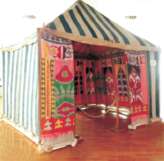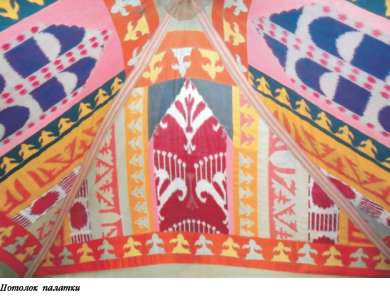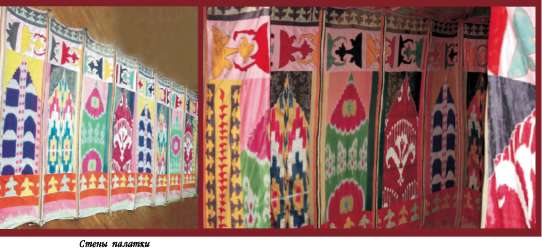 In the summer time, to escape from the heat, well-to-do citizens set in the gardens of the tent-pavilions of the cloth. Installation of tents occupied no more than 15-20 minutes, she is extremely convenient versed and was going to, that allowed to carry it on another place. According to the artist L. E. Dmitrieva Caucasian, who traveled on Central Asia in 1887-1888 , and which happen to live in a tent, “she is very beautiful, quadrangular, a 4 sq. feet (Arshin = 0,71 m), outside the canvas, bright-green colour, inside адряс (, semi-silk, the flowery Bukhara matter of which sew dressing gowns) and a very typical embroidery of two ornaments. Bright flowery and characteristic. Two doors give light a draft”. Within the established tents spread a Mat, felt carpets. The original design and comfortable interior of the created comfortable conditions for rest in the hot days. For the reception of tents were of large size. So, L. E. Dmitriev-Kavkazsky describes embroidered inside tent designed for the reception of 200 people. Different forms of the tent of four -, octahedral, round you can be connected among themselves to ensure that has fit well more people. In 2008, the impressive size the tent was demonstrated at the exhibition “in palaces and in tents. The Islamic world from Europe to China,” in the Hermitage (St. Petersburg). A. Sukharev as an ancient fishing allocated manufacture garden of tents “chodirduzi”. In Bukhara their production engaged in the wizard from the street Masters of the tents (Kuchayi-chodirduzon) quarter Kukildosh and the quarters the Eastern outskirts of the town. Sewing tents, as other crafts, is a family affair. In the classification of crafts and trades On. Sukharev considers the manufacture of garden tents to the craft, where there was a little busy the number of masters, who worked on a narrow market. To this group crafts applies, for example, the manufacture of cots, cradles, saddles, etc. In the collection of the State Museum of arts of Uzbekistan there is a tent (“chodir!”), dated XIX century. In this time she is in the permanent exposition of the Museum as one of the Fabulous tent from Bukhara National applied art of Uzbekistan different variety of products and the skill of the execution. One of the original samples of the kind of art are garden tent (“chodir!”), the most valuable exhibits of the XIX century from Bukhara. This tent published in the catalogue “the Heirs of the silk road. Uzbekistan”. It was purchased Рикмерсом in Bukhara and dates back to the 70-e gg. In XIX century. Its dimensions – 370 x 370 x 400 cm, that was nearly identical to the size of the above tents. The inner side of it are decorated with the same same way – rows of ornamented panels. Tent square form with a pyramidal roof consists of two walls. Each of them has the ten vertical divisions performed as follows: the inner side of the wall are sewed band broad woven the braid, which are inserted in the sticks with a diameter of 4-5 cm. This the solution gives an element of rigidity of construction, on the one parties and is edging panels, on the other. The roof – four spokes-sticks, built in the way described above. In the place of connection spokes stitched leather “cap”, designed to stop the center pole (“yielding”). The walls are connected with roof using mountings-buttons.
In the summer time, to escape from the heat, well-to-do citizens set in the gardens of the tent-pavilions of the cloth. Installation of tents occupied no more than 15-20 minutes, she is extremely convenient versed and was going to, that allowed to carry it on another place. According to the artist L. E. Dmitrieva Caucasian, who traveled on Central Asia in 1887-1888 , and which happen to live in a tent, “she is very beautiful, quadrangular, a 4 sq. feet (Arshin = 0,71 m), outside the canvas, bright-green colour, inside адряс (, semi-silk, the flowery Bukhara matter of which sew dressing gowns) and a very typical embroidery of two ornaments. Bright flowery and characteristic. Two doors give light a draft”. Within the established tents spread a Mat, felt carpets. The original design and comfortable interior of the created comfortable conditions for rest in the hot days. For the reception of tents were of large size. So, L. E. Dmitriev-Kavkazsky describes embroidered inside tent designed for the reception of 200 people. Different forms of the tent of four -, octahedral, round you can be connected among themselves to ensure that has fit well more people. In 2008, the impressive size the tent was demonstrated at the exhibition “in palaces and in tents. The Islamic world from Europe to China,” in the Hermitage (St. Petersburg). A. Sukharev as an ancient fishing allocated manufacture garden of tents “chodirduzi”. In Bukhara their production engaged in the wizard from the street Masters of the tents (Kuchayi-chodirduzon) quarter Kukildosh and the quarters the Eastern outskirts of the town. Sewing tents, as other crafts, is a family affair. In the classification of crafts and trades On. Sukharev considers the manufacture of garden tents to the craft, where there was a little busy the number of masters, who worked on a narrow market. To this group crafts applies, for example, the manufacture of cots, cradles, saddles, etc. In the collection of the State Museum of arts of Uzbekistan there is a tent (“chodir!”), dated XIX century. In this time she is in the permanent exposition of the Museum as one of the Fabulous tent from Bukhara National applied art of Uzbekistan different variety of products and the skill of the execution. One of the original samples of the kind of art are garden tent (“chodir!”), the most valuable exhibits of the XIX century from Bukhara. This tent published in the catalogue “the Heirs of the silk road. Uzbekistan”. It was purchased Рикмерсом in Bukhara and dates back to the 70-e gg. In XIX century. Its dimensions – 370 x 370 x 400 cm, that was nearly identical to the size of the above tents. The inner side of it are decorated with the same same way – rows of ornamented panels. Tent square form with a pyramidal roof consists of two walls. Each of them has the ten vertical divisions performed as follows: the inner side of the wall are sewed band broad woven the braid, which are inserted in the sticks with a diameter of 4-5 cm. This the solution gives an element of rigidity of construction, on the one parties and is edging panels, on the other. The roof – four spokes-sticks, built in the way described above. In the place of connection spokes stitched leather “cap”, designed to stop the center pole (“yielding”). The walls are connected with roof using mountings-buttons.  Dug in earth poles fix the tent from the outside. The outer side of the tent consists of vertically – alternating bands unpainted mats and mats the color blue. Inside, the dome of the festively decorated abr fabrics, embroidered in the form of panels, applications of satin and calico of purple, pink, yellow colors. Used not only homemade fabric, but, judging by the seals, tissue Savva Morozov. The interior of the tent is based on a traditional the interior of the living room and mehmonhona (guest room) of Bukhara houses, which are characterized by bright the painted panels, stalactite cornice, the carving on ganch, rich painting ceilings. Variously decorated niche alternate with panels. As a rule, in the living room, opposite the entrance, there is a pair of grooves for the blankets. Between them is a niche with the divisions or panels. The lower part of the niche has a large branch, while the upper part of the divided into cells, the openings of which are framed by scalloped, a carved, latticed алебастровыми tablets. A strict system location of the cells does not exist, fantasy masters and here has no boundaries. The rear wall of the the heart of a niche, painted in red, green, blue color, serves as an additional decoration of the interior. According to various niches and panels of the interior mehmonhona tent the inside is divided into twenty-panels, decorated abr tissues of the four species. In the selection of fabrics, made from a large decorative flair,
Dug in earth poles fix the tent from the outside. The outer side of the tent consists of vertically – alternating bands unpainted mats and mats the color blue. Inside, the dome of the festively decorated abr fabrics, embroidered in the form of panels, applications of satin and calico of purple, pink, yellow colors. Used not only homemade fabric, but, judging by the seals, tissue Savva Morozov. The interior of the tent is based on a traditional the interior of the living room and mehmonhona (guest room) of Bukhara houses, which are characterized by bright the painted panels, stalactite cornice, the carving on ganch, rich painting ceilings. Variously decorated niche alternate with panels. As a rule, in the living room, opposite the entrance, there is a pair of grooves for the blankets. Between them is a niche with the divisions or panels. The lower part of the niche has a large branch, while the upper part of the divided into cells, the openings of which are framed by scalloped, a carved, latticed алебастровыми tablets. A strict system location of the cells does not exist, fantasy masters and here has no boundaries. The rear wall of the the heart of a niche, painted in red, green, blue color, serves as an additional decoration of the interior. According to various niches and panels of the interior mehmonhona tent the inside is divided into twenty-panels, decorated abr tissues of the four species. In the selection of fabrics, made from a large decorative flair,  manifested creative the beginning of the wizard. With. Махкамова allocates орнаментацию ABR textiles into three main systems: the songs in the net, in the strip, in the form of integral panels. In the inner the decoration of the tents used striped fabrics and fabrics in the form of integral panels. Striped fabrics of two kinds: pattern, based on the alternation of the motives of the rectangle stylised and sickle, and with a pattern in form of a fir-trees. Patterns of integral panels are large and мадохили round rosettes. Flowery fabrics simulate painting and the songs resonate with decorative painted panels and Lancet niches of the living room. Improvised song recreate the vegetable objects, used in the paintings. Tissue rich in colorful of colours. The emphasis on a combination of purple with purple, green with pink and yellow, Bordeaux white, and blue with yellowish in colour schemes create a sense of play mother-of-pearl. It is easy to imagine a play of color, when the tent the exterior is illuminated by bright sunshine. Picturesque transitions between colors and smooth rhythm songs patterns create a sense of complete harmony. In composite building nothing is accidental, logical every detail the decor. The conventionality of motives, measured rhythm, locality flowers bring wholeness and the maximum expressiveness decoration of the tent. Observed the main component of the applied art a combination of utilitarian and aesthetic functions of the subject. Horizontal stripe the bottom panel gives the whole compositional solutions the walls of the monumental sustainability. On the red the background is given repeated the motive madohil – very popular in the Uzbek decorative art. When the unity of form – trefoil, there is a huge the variety of options motive madohil, from schematized to complicated. In the decoration of the tents used the simplified schematic the interpretation of the pattern madohil. Alternating yellow and blue-gray motives creates a clear rhythm band panel. Frieze band, which is a transition to the ceiling, transmitted in the form of two ornamented zones. On a mud- the pink background alternate colored yellow, red, blue, blue threefold motives, trimmed stylized curly branches. Blue belt ornamented near the blue мадохилей. Cornice of the dome of the ceiling of the tent repeats figure the bottom panel. The four-movement ceiling echoes and organically linked with the compositional decision of the walls. Additional inclusion of yellow colors creates warm, Sunny colors, thus increasing the visual the effect. The strict symmetry of the interior gives the balance of the and creates the impression of being static and solemnity. Speaking about the artistic dignity of the tent, I want to noted that the work of an unknown master – certificate a great taste. Despite the repetition of any motive, every time he gets a new sound, that excludes the monotony of the interior and does not tire the eyes. Tent by their design and decor is striking expediency and organically fits into the surrounding landscape. Being set in a shady garden in the summer heat it disposes to rest, recreating the feeling of Eastern fairy tales.
manifested creative the beginning of the wizard. With. Махкамова allocates орнаментацию ABR textiles into three main systems: the songs in the net, in the strip, in the form of integral panels. In the inner the decoration of the tents used striped fabrics and fabrics in the form of integral panels. Striped fabrics of two kinds: pattern, based on the alternation of the motives of the rectangle stylised and sickle, and with a pattern in form of a fir-trees. Patterns of integral panels are large and мадохили round rosettes. Flowery fabrics simulate painting and the songs resonate with decorative painted panels and Lancet niches of the living room. Improvised song recreate the vegetable objects, used in the paintings. Tissue rich in colorful of colours. The emphasis on a combination of purple with purple, green with pink and yellow, Bordeaux white, and blue with yellowish in colour schemes create a sense of play mother-of-pearl. It is easy to imagine a play of color, when the tent the exterior is illuminated by bright sunshine. Picturesque transitions between colors and smooth rhythm songs patterns create a sense of complete harmony. In composite building nothing is accidental, logical every detail the decor. The conventionality of motives, measured rhythm, locality flowers bring wholeness and the maximum expressiveness decoration of the tent. Observed the main component of the applied art a combination of utilitarian and aesthetic functions of the subject. Horizontal stripe the bottom panel gives the whole compositional solutions the walls of the monumental sustainability. On the red the background is given repeated the motive madohil – very popular in the Uzbek decorative art. When the unity of form – trefoil, there is a huge the variety of options motive madohil, from schematized to complicated. In the decoration of the tents used the simplified schematic the interpretation of the pattern madohil. Alternating yellow and blue-gray motives creates a clear rhythm band panel. Frieze band, which is a transition to the ceiling, transmitted in the form of two ornamented zones. On a mud- the pink background alternate colored yellow, red, blue, blue threefold motives, trimmed stylized curly branches. Blue belt ornamented near the blue мадохилей. Cornice of the dome of the ceiling of the tent repeats figure the bottom panel. The four-movement ceiling echoes and organically linked with the compositional decision of the walls. Additional inclusion of yellow colors creates warm, Sunny colors, thus increasing the visual the effect. The strict symmetry of the interior gives the balance of the and creates the impression of being static and solemnity. Speaking about the artistic dignity of the tent, I want to noted that the work of an unknown master – certificate a great taste. Despite the repetition of any motive, every time he gets a new sound, that excludes the monotony of the interior and does not tire the eyes. Tent by their design and decor is striking expediency and organically fits into the surrounding landscape. Being set in a shady garden in the summer heat it disposes to rest, recreating the feeling of Eastern fairy tales.
Shamuhamedova Dinara
